by: Trevor Hogg, VFXV
Designating each episode to explore the human experience of one of seven individuals – portrayed by Morgan Freeman, Helen Mirren, Anne Hathaway, Anthony Mackie and Constance Wu – is Solos creator and executive producer David Weil. The anthology series that streams on Amazon Prime Video takes place in different time periods resulting in Amazon Studios VFX Executive Juliette Yager partnering with primary vendor Ingenuity Studios on 512 shots that include a green orb, CG pool, twins and floating chalk.
"Solos was a unique project for us for a number of reasons,” states David Lebensfeld, Founding Partner and VFX Supervisor at Ingenuity Studios. "It was our first foray back into television production during COVID. We’d been part of numerous commercials and music videos that were filmed during COVID, but this was our first series. Solos also has the distinction of being our first anthology television series, each episode existing in the Solos universe but very much unique from one another. We have become accustomed over the years to creating effects that carry through episodes and seasons, so this was a nice change of pace.”
Highly-detailed previs was provided by Production Designer Ruth Ammon and Supervising Art Director Michael Allen Glover. “Their team created wonderful renderings and walkthroughs of their designs and set builds,” remarks Matthew Poliquin, Executive Producer at Ingenuity Studios. “This was fantastic for us as it allowed us to virtually scout all of the sets, helping maintain a smaller crew footprint during early days of COVID production. Their 3D set designs also helped a great deal with both the concept work and match move for CG elements in the ‘Sasha’ episode.”


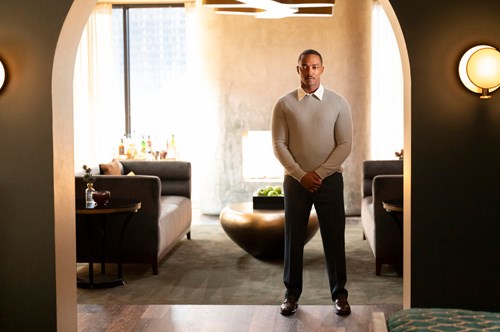
Anthony Mackie portrays twins with different personas in the episode titled ‘Tom.’ (Photos: Jason LaVeris)
“As each episode is essentially its own standalone short film, you’d think that each director would really vary wildly in style and approach, as there’s no set guidebook or guardrails as there is on an episodic. But that wasn’t the case with Solos. Our visual effects, sets and lighting were a backdrop for some of the world’s best actors to give incredibly moving performances to incredibly moving scripts.”
—Matthew Poliquin, Executive Producer, Ingenuity Studios
There were no custom software and pipeline modifications for the series. “We’ve built an incredibly flexible pipeline over the years to meet the needs of our diverse portfolio,” notes Lebensfeld. “We work on long and short-form content, television, film, commercials and music videos, and within those categories projects could consist of a handful of shots with months to turn them around, or hundreds upon hundreds with only a week.”
Asset development started in October 2020 with post-production concluding in early April 2021. “While there wasn’t any asset sharing, we did share a number of shots with Clean Plate FX,” reveals Poliquin. “It was a smooth process, as neither company’s work relied on the other, and it was always a straightforward process to determine who needed to touch it first and last.”

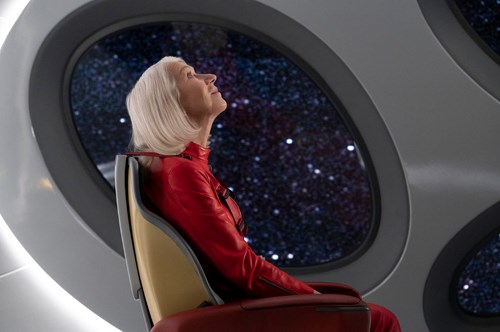
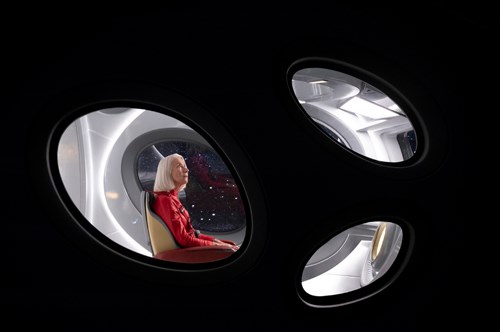
An advanced AI computer system called TYM has intelligent conversations with Peg, portrayed by Helen Mirren (Photos: Jason Laveris)
The lockdown caused by the pandemic was manageable, according to Poliquin. “The remote nature of post-production during COVID allowed editors Simon Smith and Luke Dunkley to edit from England. Roman Hankewycz colored the show from Harbor Picture Company in New York, and we did the visual effects from our Los Angeles office. It took a little getting used to having to schedule what might normally be informal pop-ins into Simon and Luke’s bays, but we all made it work smoothly.”
“Solos is such an intimate, thoughtful, character-driven show, it was important to [Executive Producer] David Weil that the graphics didn’t stand out as ‘cool’ or ‘slick,’ but instead were invisible, blending into and being part of the world.”
—Matthew Poliquin, Executive Producer, Ingenuity Studios
David Weil directed three episodes, two were helmed by Sam Taylor-Johnson and Zach Braff and Tiffany Johnson oversaw one. “As each episode is essentially its own standalone short film, you’d think that each director would really vary wildly in style and approach, as there’s no set guidebook or guardrails as there is on an episodic,” notes Poliquin. “But that wasn’t the case with Solos. Our visual effects, sets and lighting were a backdrop for some of the world’s best actors to give incredibly moving performances to incredibly moving scripts.”
“The ‘Stuart’ episode with Morgan Freeman and Dan Stevens was the only episode to include bluescreen and sky replacement,” states Poliquin. “One of the conceits of the Solos production was that everything needed to be filmed on a soundstage, on a single built set as ‘Stuart’ takes place on a beach. Ruth’s team created an amazing beach set surrounded in 270° with sunset sky backings, and cinematographer William Rexer bathed the set in a beautiful South Shore/East Coast light. Our ‘sky replacement’ work was really zhuzhing up the backings, bringing them to life and better matching them to the matte painting sky we added over the ocean for the entirely bluescreen shots facing out towards the ocean.”
The UI had to assist the storytelling. “Solos is such an intimate, thoughtful, character-driven show, it was important to David Weil that the graphics didn’t stand out as ‘cool’ or ‘slick,’ but instead were invisible, blending into and being part of the world,” notes Poliquin. “The challenge for us was that while the show takes place in the same world, there’s a 60-plus year span across the various episodes. Because of this, our graphics work, led by Alex Popkin, needed the same base technology and UI, but had to evolve over the years. Rather than designing a radio or doorbell graphic for a specific time period, we created an evolutionary chart for how people would interact with technology over the years, how iconography would change over the years [the recent change from a handset to a smartphone as the ‘phone’ icon, for example].”
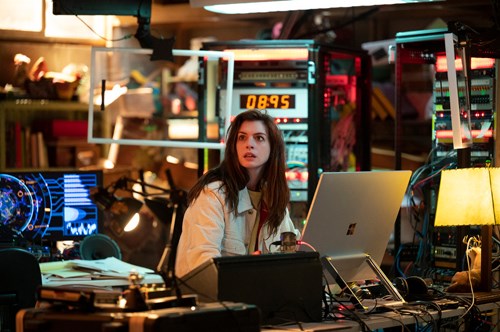
Leah (Anne Hathaway) uses a white spherical ord for communication and as a journal. (Photos: Jason Laveris)
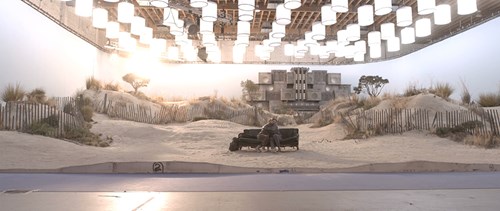

Sky and beach replacement were required for the episode called 'Stuart'
“The challenge for us was that while the show takes place in the same world, there’s a 60-plus year span across the various episodes. Because of this, our graphics work, led by Alex Popkin, needed the same base technology and UI, but had to evolve over the years. Rather than designing a radio or doorbell graphic for a specific time period, we created an evolutionary chart for how people would interact with technology over the years, how iconography would change over the years.”
—Matthew Poliquin, Executive Producer, Ingenuity Studios
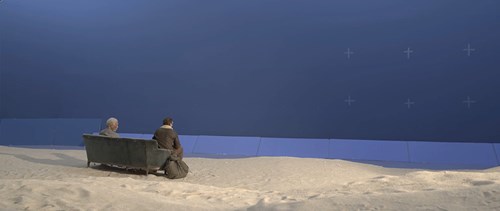

Morgan Freeman and Dan Stevens portray Stuart and Otto against bluescreen
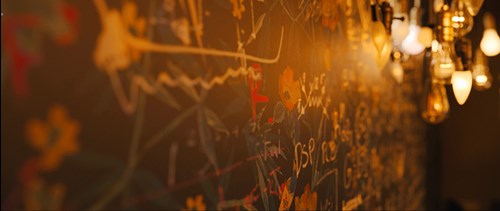
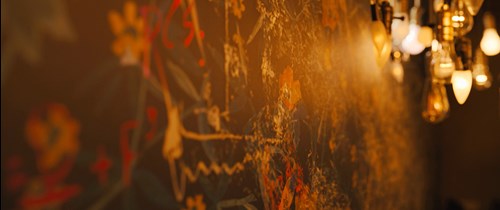
One of the lab walls is covered with math equations written by Lean (Anne Hathaway) in chalk.
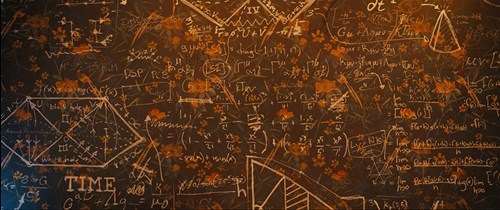
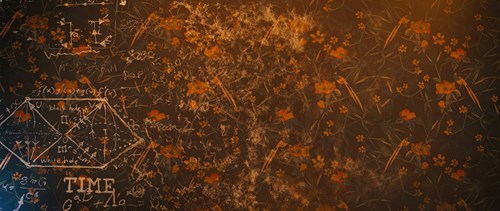
Chalk detaches and floats away creating the impression that time is becoming undone.
“This sounds really, really cheesy, especially from someone at a visual effects company, but I hope no one even thinks about the work that went into every shot and every sequence.”
—Matthew Poliquin, Executive Producer, Ingenuity Studios
Anthony Mackie plays identical twin brothers in the episode called ‘Tom.’ “A body double was used for the over-the-shoulders, and split screens were employed for most of the two-shots,” explains Poliquin. “There’s a moment when Tom teaches the other Tom a secret handshake, and for this interaction we had Mr. Mackie play both sides of the action against his body double, blending the doubles arm into Mr. Mackie’s. The episode was our smoothest, thanks to our on-set VFX Supervisor Andrew Woolley.” The challenge for the ‘Peg’ episode featuring Helen Mirren was creating a visually interesting journey while maintaining an appropriate pace for the key story points. “We couldn’t have her zipping through the solar system passing each planet, as the story has her recently embarking and passing the Moon,” adds Poliquin. “It was a bit of a puzzle, staging shots against the black vastness of space, lit per the already established sun, and still creating a sense of progression.”
‘Leah’ with Anne Hathaway was the most complex episode, reveals Poliquin. “It offered the widest variety of effects: pulsating orbs, enhancement of special effects, set pieces vanishing and writing being erased,” remarks Poliquin. “This was also one of the episodes that we shared with Clean Plate FX, so it added an extra layer. None of these were difficult per se, but this episode featured the most unique items that required creative look development.”
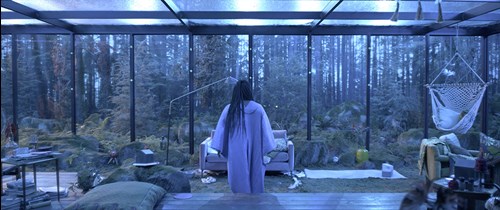
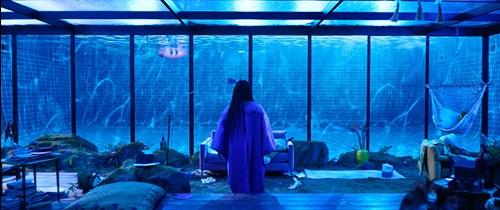
The windows were chnaged to make it look like the house which Sasha (Uzo Aduba) lives is at the botttom of a pool.
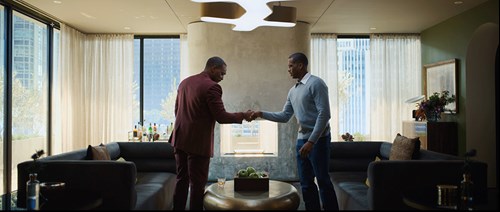
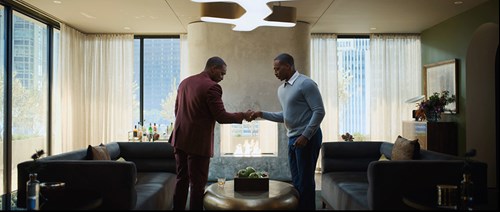
The stunt-double proportions had to be digitally altered to match Anthony Machie when the twins shake hands.
A unique visual effect was the floating chalk. “Do you know what it looks like when time is being erased and, due to the laws of nature, chalk loses its ability to adhere to the board, before ultimately vanishing? We sure didn’t at the start! We started the chalk falling work in After Effects to allow us to quickly generate temps for the offline edit and to start our concept work. Our graphics team has some great tools for the forming and erasing of text and artwork, so they worked out the timing and flow of how and where the chalk would erase. That animation was handed off to Paul Baran in our FX Department, who created the particle effect.”
Simulations were not a major necessity. “This series was light on simulations, with the only simulation being the water’s surface and subsequent caustics in ‘Sasha,’” states Poliquin. “Our biggest challenge was certainly the graphic design, creating a harmonious, graphics language that varied significantly in its application and evolution. We don’t often have to ask and answer if the virtual doorbell, greater 65 years in the future, is on the same timeline and trajectory as the personal assistant AI five years from now, and the radio in eight years.” The mandate was to be invisible. “This sounds really, really cheesy,” Poliquin admits, “especially from someone at a visual effects company, but I hope no one even thinks about the work that went into every shot and every sequence. But if I had to choose, ‘Stuart’ offers the most on-screen visual impact.”
Producer: Pixie Wespiser
Article

















